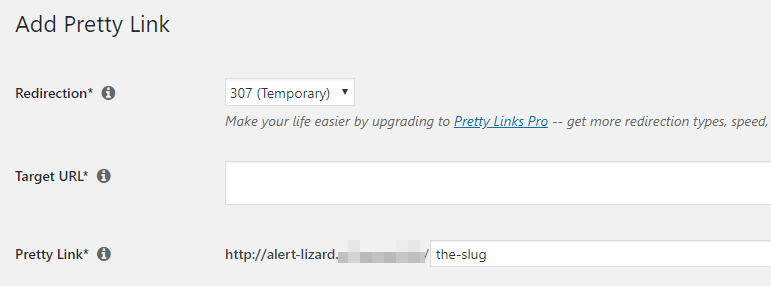Otros 3 errores al acortar enlaces (y cómo evitarlos)

Contenido
There are a lot of reasons you’d want to shorten your links. It makes them easier on the eyes, for example, and it can be great for marketing purposes. The problem is that there are some pitfalls you need to avoid when it comes to shortening links, especially if you want to get the most out of the process.
We’ve already talked about some of the errores más comunes de acortamiento de enlaces que comete la gente, como enlazar a contenidos de baja calidad y utilizar mal el texto de anclaje. Sin embargo, aún nos queda algo de terreno por recorrer, para que puedas evitar errores y acabar con una estrategia de enlaces más sólida.
In this article, we’re going to briefly review why link shortening can benefit you. Then we’ll introduce you to three (more) link shortening mistakes you need to avoid, and talk about how to do that. Let’s jump right in!
Por qué acortar enlaces es una estrategia vital
El acortamiento de enlaces es un proceso en el que se toma un enlace largo y desordenado y se transforma en algo más corto y manejable. Por ejemplo, imagina que una de las entradas de tu blog tiene esta URL:
yourwebsite.com/blog/2018/05/02/postid=4534523
Ese enlace es largo, desordenado y no dice nada al lector sobre el contenido al que conduce. Con un acortador de enlaces, podrías tomar esa URL y sustituirla por algo como esto:
yourwebsite.com/article-name
Si usted utilice una herramienta profesional de acortamiento de enlaces, you can use any text you want for your shortened links. However, link shortening is not just for cosmetic purposes. ‘Pretty’ links can also help to mejorar el porcentaje de clics and your affiliate marketing strategy. You can even use shortened links to reinforce your branding, so they’re a great addition to almost any website. That is, at least if you tackle link shortening the ‘right’ way.
3 (más) errores de acortamiento de enlaces que debe evitar
If you haven’t read our previous piece on errores comunes al acortar enlaces, we’d suggest checking it out after you’re done with this one. That way, you’ll know everything you need to avoid when working on your links.
1. No incluir su marca en los enlaces
First up, let’s talk about branding. Ideally, all of your shortened URLs will include your site’s brand within them. Otherwise, you’re missing out on a key marketing opportunity, and visitors might even think that you’re using links from another site.
Además, el uso de su marca para los enlaces externos mantiene la coherencia en todo su sitio web. Con Pretty Links, your brand becomes part of each shortened link you create automatically. All you have to do is choose what comes after it, which is what we call the ‘slug’:

We’ll talk more about URL slugs shortly. For now, let’s move on to redirects.
2. Utilizar el tipo de redireccionamiento incorrecto
One common misconception behind link shortening is that you’re transforming one URL into another. However, you aren’t actually erasing the original link. Instead, what you’re doing is creating a new link and pointing it towards the original one, using something called a redirect.
Como ya sabrá, existen varios tipos de redireccionamientos. Cuando se trata de acortar enlaces, los tipos a los que tenga acceso dependerán de la herramienta que utilice. Por ejemplo, con Pretty Links, puede utilizar ocho tipos de redireccionamientos.
However, in most cases, you’ll want to stick with one of two options, which are:
- Redirección 301. This is what’s called a ‘permanent’ redirect, since it tells search engines to pass on the ‘link juice’ from one URL to another. You should only use this redirect if you’re sure the target URL won’t change later on.
- 307 redirección. This is known as a ‘temporary’ redirect, and is always safe to use. It doesn’t pass on any link juice, since the target URL might change.
Generally speaking, you’ll want to use 307 redirects for external links, since those might change at some point and are outside of your control. 301 redirects, on the other hand, are perfect for internal shortened links.
Para simplificar esta tarea, Pretty Links le permite elegir el tipo de redirección de una lista cada vez que acorta una nueva URL:

Sólo tiene que comprobar a qué categoría pertenece su URL de destino y elegir una redirección en función de sus características.
3. Ajuste de las babosas genéricas
Last but not least, it’s time to talk about slugs. A slug is the section of a URL that identifies a particular page. For example, in the URL yourwebsite.com/page-oneel slug es "página uno":

Cuando acortas un enlace utilizando las herramientas adecuadas, puedes elegir un slug para la URL que generas. Esta es una oportunidad ideal para establecer un nombre que previsualiza el contenido de la página de destino, y se verá bien a los visitantes.
However, what a lot of people do is use overly generic slugs. Imagine, for example, that you’ve written a comparison article on the best running shoes you can buy. Here are two shortened link options you might use:
- yourwebsite.com/zapatos
- yourwebsite.com/mejores-zapatos-de-correr-2018
The second option is superior. Although it’s longer, it tells visitors exactly what to expect. Plus, it even includes a ‘timestamp’, so people can see that the content is fresh (encouraging them to click on it). No matter what the content is about, what’s important is to focus on coming up with a slug that’s descriptive, yet not too long.
Conclusión
Mucha gente utiliza acortadores de enlaces sin pensar demasiado en cómo they’re using them. Shortened links can benefit your website in a lot of ways, from reinforcing your brand to gathering better data about your affiliate linking strategy. However, if you don’t implement link shortening carefully, you won’t see the results you’re hoping for.
We’ve already talked about some of the errores de acortamiento de enlaces que debe evitar. A continuación, le presentamos otras tres técnicas que debe tener en cuenta para asegurarse de que su estrategia de enlaces es la correcta:
- Incluya su marca en los enlaces.
- Utilice el tipo correcto de redirección para cada URL.
- Evite utilizar babosas genéricas.
¿Tienes alguna duda sobre cómo acortar tus enlaces correctamente? Pregúntanos en la sección de comentarios.